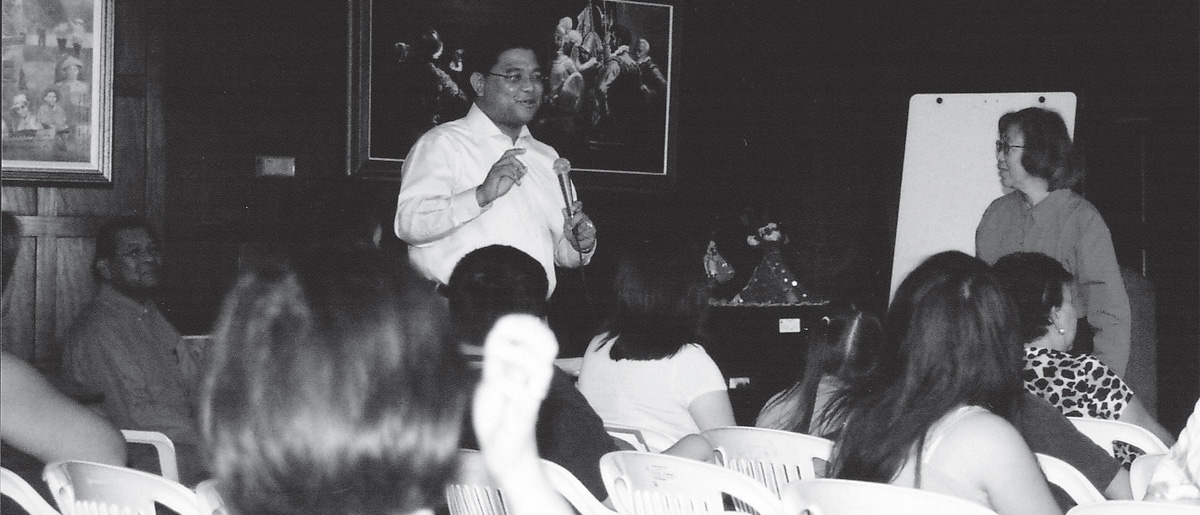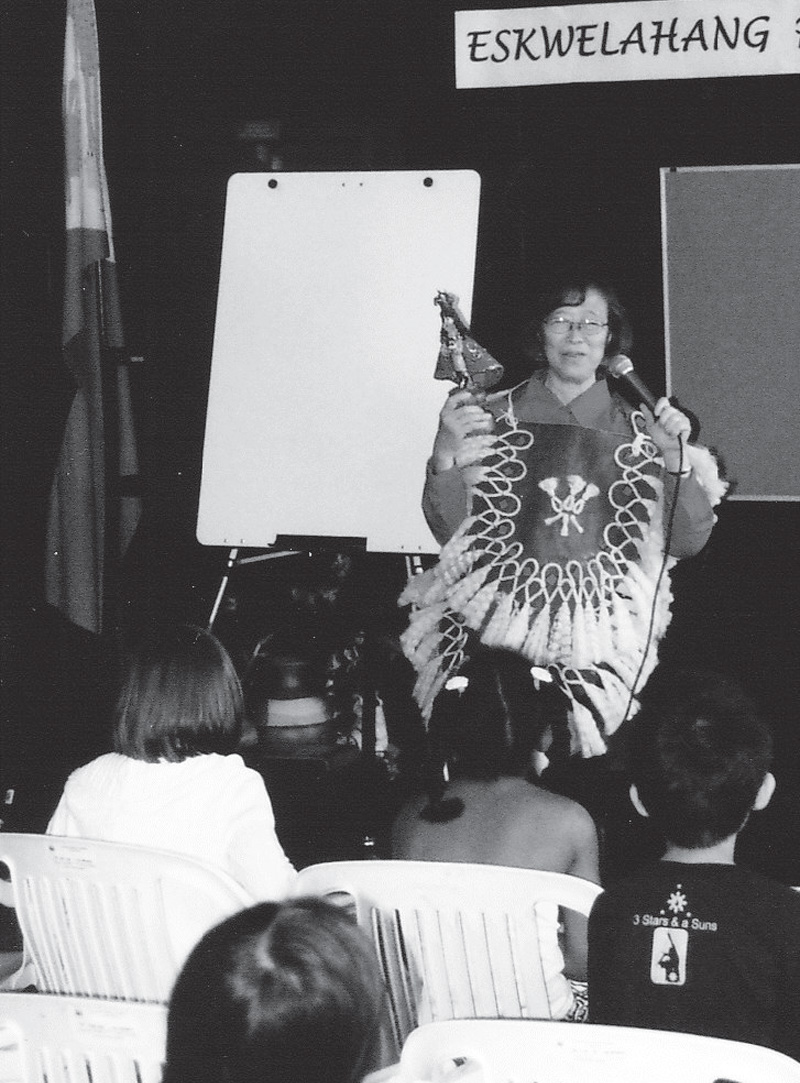
Aug 6, 2010
Philippine Cultures & Languages Part two
‘Bayang magiliw, Perlas ng Silanganan Alab ng puso, Sa Dibdib mo’y buhay. Lupang Hinirang, Duyan ka ng magiting, Sa manlulupig, Di ka pasisiil. Sa dagat at bundok, Sa simoy at sa langit mong bughaw, May dilag ang tula, At awit sa paglayang minamahal. Tagalog the national language of the Philippines is peppered with a generous sprinkling of Spanish, Chinese, English, and tribal Tagalog. Unlike more classical Oriental languages, Pilipino is pronounced as it’s spelled-phonetically. Dr. Evelyn De Asis Natividad gave an extensive lecture on grammatical and conversational Tagalog to the older kids and adults while co-lecturer Sally Richmond worked with the smaller children. The twin lectures took place immediately after the singing of the National Anthem and introductory talk.
A colorful slide show depicting the many religious and secular customs of the Islands followed the language lecture. Not one for silent audiences, Dr. Natividad hosted a round robin question and answer session that involved each class member. My contribution was in reading an entire page of customary Tagalog greetings with responses. The audience rewarded my efforts with a round of applause.
MUSLIM MINDANAO
Muslim princess and former Miss Philippines Emraida Kiram gave us listeners a lecture on the varied colorful customs and traditions of Muslim Filipinos. She described in vivid details what life is like for members of Mindanao’s high bred Muslim community using her own family as examples. She spoke of her student days in Europe, her suspension of Muslim tradition by running for-and winning-the Miss Philippines title, Islamic marriage traditions, the colorful malong she was wearing and it’s many uses, her job in the Registrar’s office of the University of Wisconsin, to her explaining that not all Muslims are terrorists.

DCG Castro with Sol lecturing about Filipino Religious Traditions
Princess Kiram talked about Muslim courtship and marriage customs in her native Mindanao (Her father was Sultan of Jolo.); when she concluded she solicited questions from listeners. Princess Kiram was also a Miss World candidate who represented the Philippines.
LET’S DANCE!
Near the tail end of last week’s program there were some costumed teenagers carrying two long poles. I left early and never saw them dance. From the long sticks they were carrying more than likely the dance was the traditional ‘tinikling the national dance of the Philippines. Reader, if you’re not Filipino let me explain the dance for you. ‘The tinikling is an indigenous dance that involves two people beating, tapping, and sliding bamboo poles on the ground against each other in coordination with one of more dancers who step over and in between the poles in a dance. The name refers to birds locally known as tikling which can be any of a number of rail species; the term tinikling literally means tikling-like.’

Sol in Ati-Atihan costume holding Senor Santo Nino image
If you want to learn more about this dance go to: ‘Tinikling-Wikipedia…’ or Watch and listen to: YouTube-Filipino stick dance.
Reader I’m not much of a dancer despite some of your more unenlightened readers who’d assume that your beloved writer is genetically and racially disposed to the art of the dance. Plain truth is I have as much natural rhythm as a one-legged hippo at a track meet. About shaking my booty I don’t have one. I’m flat butted.
If the colorful dances of the Philippines are something you would like to learn more about log in to :
www.americandancecenter.net or email : americandancecenter@att.net for more information.
If they can’t help you they’ll direct you to sources that could.
LET THERE BE MUSIC.
All oppressed peoples have their renditions of what I term ‘slave music.’ Filipinos under their captors (Spanish, American, Japanese then Americans again) had theirs. Like the ‘Negro Spirituals’ of American slavery days, oppressed Filipinos sang of their sorrows, wishes, and dreams to all who would listen. Their songs also contained coded messages as to locations of secret meeting, current events, and where the next insurrection would be staged. Unlike America’s Blacks the slave songs of the Philippines are mostly lost to posterity. LOOSE ENDS The lecture teams took turns educating us about various island customs that needed extra attention.
How the women of the Archipelago were key players in the Revolution and how they died in defense of national identity and freedom. Particular attention was given to Ms. Maria Gabriela Carino Silang born St. Joseph’s Day (March 19th)1763 executed along with her 2nd husband Sol in Ati-Atihan costume holding Senor Santo Nino image on St. Michael’s Day (September 29th) 1763 under orders from Spanish government and Catholic Church authorities in Manila for their participation in insurrectionist activities. Gabriela was hung along with her husband and three others. She took the longest time to die; one brave lady who died hard. (Source: Gabriela Silang-Wikipedia) The 2 ½ hour session ended the usual way with a festive merienda and small group’s discussion. Again I had to leave early.
APPRECIATION DAY
Next week (August 7th) the third and final week will be Appreciation Day when Philippine Consul General Leo M. Herrera-Lim will officially close this year’s program. After the consul general’s introductory talk there will be an all Philippine musical presentation by Ms. Ester Hana. Her talk will be followed by one with Mr. Victor Ricolcol of Adeline’s Food Catering Services, organizing Fil-Am Associations, cultural presentations by class participants, and lastly the presentation of certificates to those who participated in the four consecutive Saturday classes. In next week’s Mega Scene’s Philippine Adventures we’ll take a futuristic journey to what the Philippines will be like once it achieves first world status. Our pretend trip will focus on what Filipinos will have to do to ward off unscrupulous multi-nationals and their attempts to under mind the newly emerged economic giant that will comprise the Philippine Republic of tomorrow. How Filipinos will have to struggle to retain sovereignty against foreign ‘devils’ white and otherwise in their attempts to regain control of the minds and monies of the masses. Till then GOD bless you, drive carefully, stay the course and never give up.
“Anyone who does not know how to look back at where they came from will never get to where they’re going.”
-Jose Rizal-



 ShareThis
ShareThis